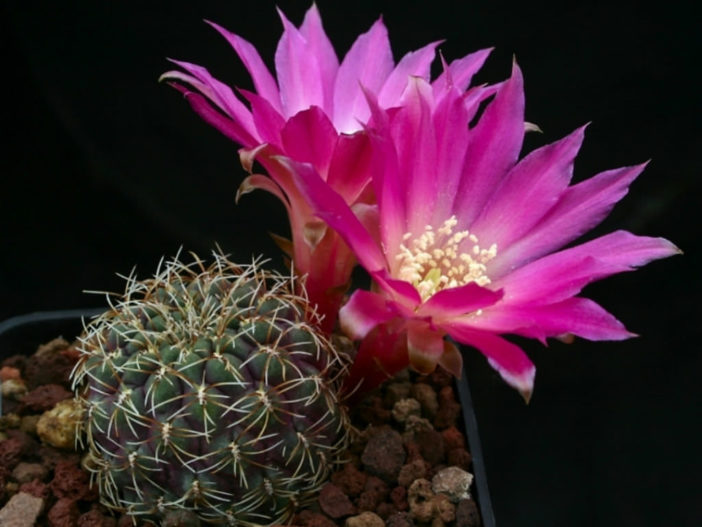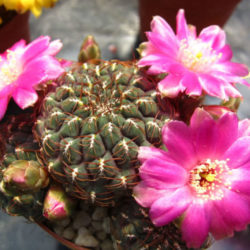Scientific Name
Rebutia pulchra Cárdenas
Synonym(s)
Rebutia canigueralii subsp. pulchra, Sulcorebutia pulchra, Weingartia pulchra
Scientific Classification
Family: Cactaceae
Subfamily: Cactoideae
Tribe: Trichocereeae
Genus: Rebutia
Description
Rebutia pulchra is a cactus that branches profusely to form a mound as it matures. The stems are dull olive-green tinged with red to dark violet, up to 2 inches (5 cm) in diameter and up to 1.2 inches (3 cm) tall. They are covered by flat tubercles, which vary in color between dark green and violet. In older plants, tubercles are arranged in up to 16 spiral lines merging in the apex. The areoles are narrow with short white felt. Spines are yellow or brown and up to 0.4 inches (1 cm) long.
Flowers are pale to dark magenta or red, sometimes bicolored with white throats, up to 1.6 inches (4 cm) long with equal diameter. They appear in late spring.

Hardiness
USDA hardiness zone 9a to 11b: from 20 °F (−6.7 °C) to 50 °F (+10 °C).
How to Grow and Care
If you can grow cacti and succulents successfully, you can likely grow the popular Rebutia without too much trouble. Their water and light requirements are pretty typical for many cacti species, including a cooling period in the winter to promote better blooming. Watering should be done carefully, allowing the plant to almost dry out between waterings. The cactus mustn't be exposed to prolonged dampness and sitting water. Never let your cactus sit in a dish of water. Instead of propagating your offsets, let the plant form a large cluster for the best viewing. When it blooms, this will make a stunning display. Lastly, ensure to fertilize during the growing season for the best results.
Repot as needed, preferably during the warm season. To repot a cactus, ensure the soil is dry before repotting, then gently remove the pot.
See more at How to Grow and Care for Rebutia.
Origin
This species is native to Bolivia.
Links
- Back to genus Rebutia
- Succupedia: Browse succulents by Scientific Name, Common Name, Genus, Family, USDA Hardiness Zone, Origin, or cacti by Genus
Photo Gallery
Click on a photo to see a larger version.



